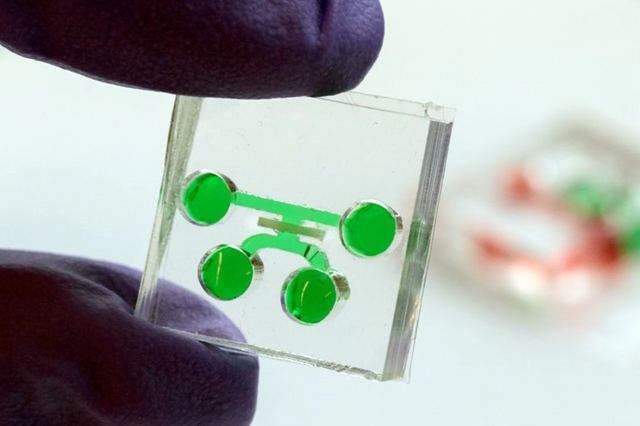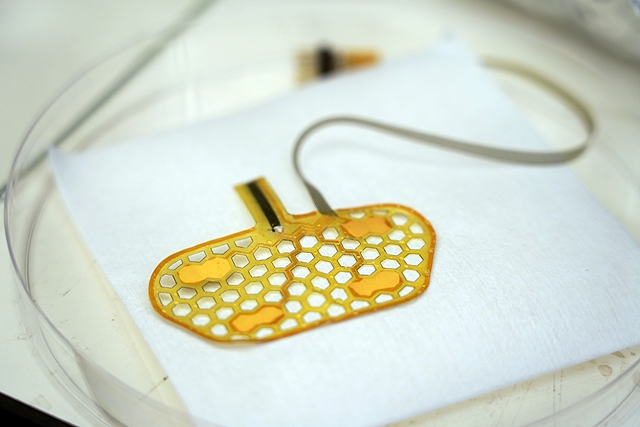Subscribe for email alerts
Donate to Science & Enterprise
|
By Alan, on December 20th, 2019  Tooth-on-a-chip device (Kristyna Wentz-Graff, Oregon Health and Science University) 20 Dec. 2019. Dentistry researchers created a model of a tooth that simulates on a plastic slide the architecture and dynamic stresses in human teeth. A team from the Oregon Health and Science University in Portland describes the device in yesterday’s issue of the journal Lab on a Chip (paid subscription required).
Researchers from the lab of OHSU dentistry school professor Luiz Bertassoni are seeking better ways to find more effective materials for preventing and repairing problems with teeth, as well as regenerating new tooth tissue. While biological and chemical functions in the mouth are widely studied, a lab model for simulating the unique bio-materials and environment has not yet been developed, even as other organ-on-chip models are becoming available.
The tooth-on-a-chip device is built on a small base of polydimethylsiloxane, or PDMS, a silicone polymer used in many biomedical applications. The PDMS base holds a slice of dentin, the material that makes up much of the tooth tissue, from a human molar. The dentin slice is seeded with stem cells that transform into pulp tissue protected in the mouth by dentin.
The OHSU team designed the chip to learn more about the progression of tooth cavities and to test materials for filling those cavities. “Today’s cavity fillings don’t work as well as they should. They last for five, seven years on average, and then they break off,” says Bertassoni in a university statement. “They don’t work because we haven’t been able to figure out what’s happening at the interface of the tooth and the filling.”
The researchers used the chip to test several of today’s dental materials, and compared the results to standard testing methods. The results show the chip measured potential cell toxicity of the materials as well as current testing methods, but found the materials metabolized more on the chip than in off-chip tests. In addition, the researchers could track in real time interactions between dentin and pulp cells, suggesting a more prominent role for pulp cells in creating enzymes that contribute to tooth decay.
The researchers believe the tooth-on-a-chip can provide a valuable tool for dentists to find dental materials that better meet the molecular nature of individual patients. “Years from now,” notes Bertassoni, “dentists could extract a tooth from a patient, load it into this device, observe how a dental filling material interacts with the tooth, and pick a material that’s best for that particular patient.”
Bertassoni’s lab studies fabrication, including 3-D printing, of biomaterials for tissue engineering and regenerative medicine. An invention from the lab, similar to tooth-on-a-chip, is BoneMimetics that provides a platform for drug discovery using more realistic bone models than currently available for preclinical studies. BoneMimetics uses a hydrogel material seeded with bone tissue cells that calcifies in a lab dish to form real bone, which received funding from the university’s technology transfer office to advance the innovation to the marketplace.
More from Science & Enterprise:
* * *
By Alan, on December 20th, 2019 – Contributed content –
 (Lukas, Pexels) 20 Dec. 2019. As an introvert, you may assume that you do not have what it takes to be a successful project manager. Just because you are not the loudest and most open person in the world does not mean that you do not have what it takes to be a successful project manager. In fact, some of the most successful entrepreneurs around the world are introverts. We’re talking Bill Gates, Mark Zuckerberg and co! If you are an introvert, you can definitely use these successful people as inspiration. You can also use the tips below to help you achieve a successful career in project management.
Stay away from any sort of scenario that causes over-stimulation
One typical trait of an introvert is that their sensitive brain chemistry means it is easy to get over-stimulated. Does this sound familiar? Managing this is important in order to be successful. You need to begin by ensuring you are self-aware and that you can recognize the sort of scenarios that would cause you to get frustrated and irritated with easy. Once you have done this, to reduce any inconvenience in the workplace, find a successful workaround so that the said scenarios do not stress you. There are lots of different approaches that can help you with this. It is all about self-regulation.
Master the art of effective delegation
Delegation is pivotal for any type of project manager if you are to manage projects successfully, especially one who is introverted. The value of delegating tasks effectively is something that all project manager need to recognize. By doing this, you will then have the capacity to focus on the strategic elements of your role. Not only this, but if you delegate activities appropriately, you will also be able to generate confidence within your team and build rapport. Micromanaging tasks, on the other hand, is counterproductive. Make sure you know how to assign the right tasks to the right people.
Improve your brainstorming sessions
Brainstorming is something all business project teams use in order to solve problems. In fact, you probably do not even realise you are doing it half of the time. However, it is a great method for coming up with creative solutions to issues and new ideas. Despite this, if you are to use this approach as effectively as possible, you need to consider your brainstorming sessions and ensure there is a structured and considered approach to them. With that being said, read on to discover some useful tips on enhancing the effectiveness of your brainstorming sessions.
Make sure you have a purpose – There is only one place to begin, and this is with having a purpose. This is something that students are often taught during project management courses with regards to holding effective meetings. This is because a lot of project managers have meetings for the sake of it, or they schedule a meeting and do not structure it or have a plan regarding what is going to be discussed. This is a recipe for disaster. After all, you are only going to have a good input if people know where all of their efforts are going.
Establish some ground rules – Another common problem with brainstorming sessions is that people have a tendency to talk over one and other. Because of this, solutions can often get confused and it is hard to keep focus. This is why you need to establish a set procedure that should be followed during every brainstorming session. For example, you could suggest that anyone who wants to speak raises his or her hand so that communication flows in a peaceful manner.
Reward people who are creatively courageous – This is an important one because you need to create an environment whereby people are not afraid to share their ideas, no matter how silly they may seem. You need to make sure that everyone feels comfortable. Reward people that are courageous with their creativeness, even if they present an idea that you do not follow.
Guide the discussion – Last but not least, as the project manager, it is up to you to guide the discussion and ensure it flows. One of the smartest ways to go about this is to build on ideas. Make sure everyone is encouraged to contribute. Moreover, stick to one idea at a time, otherwise focus is lost and the discussion will end up being sidetracked. At the same time, you need to generate numerous ideas and make sure you do not stay on the same line of thought for too long.
Recognize when the time is right to step out of your comfort zone
Working alone tends to be the most desired environment for introverts. If you do not like spending much time with other people, this can be a bit of a barrier in project management, as you are going to need to interact with others. The more you do this, the easier it will be. Make sure you interact with your team members and all stakeholders regularly. The longer you leave it, the more difficult it will become.
Use Gantt charts to improve your work
When planning for a project, there is a lot that needs to be considered. One of the most important factors is determining what you and your team are actually going to need to make the project a success. You need to consider everything from the resources your team requires to the reporting methods you are going to use. In this post, we are going to take a look at Gantt charts and whether they are required for your project.
What is a Gantt chart?
This is a chart that features a number of horizontal lines that show production completion or the amount of work that has been done for a specific period of time in regards to what you had planned to be completed in this period. It is one of numerous tracking and monitoring approaches that are taught during project management training courses. Gantt charts can be very beneficial, but they are not required for all projects, and so you need to work out whether you need one or not.
Do you require a Gantt chart?
There are a number of different factors to consider to determine whether you need a Gantt chart. Firstly, you need to think about the nature of the project you are working on. Gantt charts are better for projects that demand long-term planning. You also need to consider the complexity of the project you are working on. Complex projects are the most challenging to manage because there are so many variables that can play a part. This is where Gantt charts really show their worth, as they give you the ability to link all of these variables with the scheduling.
Not only do you need to think about the nature of the project, but you also need to assess the capabilities of your team. Gantt charts may be an unwanted problem if your team has very limited project management skills and experience. If they have never worked with project management software before, you need to decide whether the learning curve they need to go on is going to be worth it. This also leads to the final point, which is the software. If you are going to proceed with this approach, you are going to need Gantt software that is user-friendly. You could even find a bit of middle ground and choose software that gives you the capacity to use bits and pieces of various methodologies, rather than sticking to one rigid approach.
Take a project management training course
Last but not least, the importance of project management training should not be underestimated for any aspiring project manager. You may also want to consider a project management apprenticeship as an introvert, as this will enable you to get your foot in the door and get the experience you need. It will be scary at first, but overall you ease your way into the industry as you already have the expertise required.
So there you have it: some of the different steps that you can take in order to improve project management, including some special tips specifically for introverts. Some of the best project managers and leaders are introverts, so do not let this deter you from being an effective and successful project manager. You can do it.
* * *
By Alan, on December 19th, 2019  Microscope image of vaccinia virus (CDC, Pixnio.com) 19 Dec. 2019. A biotechnology company developing cancer immunotherapies with synthetic viruses is licensing its technology to Takeda Pharmaceuticals. The deal with Takeda is expected to bring Turnstone Biologics Inc. in Ottawa, Canada and New York at least $120 million in milestone payments and equity investments, with additional payments of up to $900 million possible if the partnership is extended.
Turnstone Biologics creates treatments for cancer with an engineered form of the vaccinia virus, a microbe known for centuries and the basis for early vaccines, such as for smallpox. The vaccinia virus is also the backbone of Turnstone Biologics’s technology, designed to stimulate the immune system against tumors. The company says its engineered vaccinia virus is enhanced to better recognize antigen proteins that invoke immune responses and take on the micro-environment that supports tumor growth.
Turnstone Biologics says that because of vaccinia’s larger size, the company’s engineered form of the virus can accommodate larger therapeutic payloads. Its lead product, code-named Rival-01, addresses three targets: a binding protein known as FLT3 on the surface of cells, an antibody protein called CTLA-4 that acts as a checkpoint to prevent the immune system from attacking cancer cells, and the cytokine protein interleukin-12 that invokes an immune response against tumor cells.
The deal gives Takeda Pharmaceuticals, a global drug maker headquartered in Tokyo, an exclusive worldwide license to co-develop and commercialize Rival-01, equally dividing costs and profits with Turnstone Biologics. In return, Turnstone receives $120 million in initial and milestone payments, and equity investment from Takeda.
Sammy Farah, CEO of Turnstone, says in a company statement released through BusinessWire that, “this partnership allows us to co-develop and co-commercialize Rival-01 together with Takeda, enabling us to broaden our internal capabilities and expand our viral immunotherapy pipeline, while retaining our ability to independently develop other candidates based on this technology.”
Takeda Pharmaceuticals has a number of cancer drugs approved and in its pipeline, including immunotherapies. The agreement with Turnstone is expected to expand its cancer drug offerings, with a different approach to immunotherapies. “Our partnership with Turnstone,” says Chris Arendt who head’s Takeda’s oncology drug discovery unit, “and its vaccinia virus platform will help us harness the power of the immune system in unique ways to address some of the most difficult-to-treat cancers.”
The companies are also expected to collaborate on development of new products from Turnstone’s vaccinia virus platform, with Takeda given the right to license new treatment candidates from that platform, and Turnstone retaining ownership of other candidates. From this extended collaboration, Turnstone will be eligible for $900 million in development, regulatory, and commercial milestone payments, as well as royalties on sales.
Turnstone Biologics is a five year-old company founded by cancer researchers John Bell of Ottawa Hospital Research Institute, David Stojdl at University of Ottawa, and Brian Lichty of McMaster University in Hamilton, Ontario.
More from Science & Enterprise:
* * *
By Alan, on December 19th, 2019  Quantum dots reflecting ultraviolet light (Marc Vidal, Wikimedia Commons) 19 Dec. 2019. A plastic vaccine patch is shown in lab animals to also store an invisible record of that vaccination under the recipient’s skin, displayed with a smartphone. A team from Massachusetts Institute of Technology and other institutions describe the vaccine delivery and recording patch in yesterday’s issue of the journal Science Translational Medicine.
Researchers from the lab of biomedical engineering and materials science professor Robert Langer are seeking a better process for recording a patient’s vaccine history. In many parts of the world, and even in some advanced societies, medical records are uneven in quality or consistency, if they exist at all. As a result, say the authors, an estimated 1.5 million preventable deaths occur each year due to lack of vaccination.
“In order to be protected against most pathogens, one needs multiple vaccinations,” says Ana Jaklenec, research scientist and co-senior author of the paper in an MIT statement. “In some areas in the developing world, it can be very challenging to do this, as there is a lack of data about who has been vaccinated and whether they need additional shots or not.”
To provide a safe and reliable way to record an individual’s vaccine, the researchers devised a patch to deliver the vaccine, while at the same time deliver a record of that vaccine in the recipient’s skin. A bio-compatible plastic patch with tiny needles to penetrate only the very outer layers of skin with little or no pain has been shown as an inexpensive and feasible drug delivery method, including for vaccines. A report in August on Science & Enterprise from colleagues at MIT is a recent example.
Langer, Jaklenec, and colleagues fabricated their vaccine delivery patch from polyvinyl acetate, or PVA, a bio-compatible polymer, with microscale needles. The needles, 1.5 millimeters long, are made from a combination of PVA and sugar that dissolves to release the vaccine and a fluorescent dye. The dye contains nanoscale semiconducting crystals called quantum dots that are invisible to the naked eye, but still respond to light.
In this case, the quantum dots are made with a core of copper indium selenide and a shell of zinc/aluminum sulfide to respond to near-infrared light rays, as well as resist bleaching from exposure to sunlight. The quantum dots are delivered under the skin’s surface inside clear, common PMMA or acrylic polymer spheres for long-term wear.
The team also designed a reading system using a smartphone’s camera. To read quantum dots, the camera is outfitted with a condenser and filters added to the phone’s case to emit a near-infrared signal that penetrates the outer skin layer and excites the quantum dots. The same equipment then filters out background light and captures responses from the quantum dots. The team also wrote an algorithm using a public image analysis and machine learning network to interpret the signals and information patterns from the quantum dots.
The researchers tested the vaccine delivery and recording patch with lab rats. The team first tested the patch in live rats without a vaccine for evidence of toxicity and other adverse reactions, and found localized reactions to skin punctures, but otherwise the patches are well tolerated by the animals. Tests of the patch in rats with the Salk polio vaccine show the device delivers equivalent amounts of the vaccine and produces an immune response similar to conventional injections. Separate tests with rats show quantum dots delivered by the patch can be read and interpreted with a smartphone up to nine months following their application.
The researchers now plan to expand the amount of information that can be stored and retrieved with quantum dots, and will survey health care workers in developing areas on implementing the process. MIT applied for a patent on the technology, with several of the authors listed as inventors.
More from Science & Enterprise:
* * *
By Alan, on December 19th, 2019 – Contributed content –
 (Rawpixel, Unsplash) 19 Dec. 2019. Saving money in business is always going to be something that any company can benefit from. Whether that’s as a start-up where every penny counts, to big businesses who are trying to save and spend their money where it makes a difference. Here are some tips to save money in business.
Try outsourcing
Outsourcing can be a really handy way to save money but to also continue where your business is going without having to stall because you haven’t got the right resources or skills available within the company. When outsourcing, look at what you need and how often you need to get this help outsourced. Outsourcing can become more of an expense if you’re using it all the time and instead you might as well recruit someone in-house to save money at that point. Always look for those companies that are reputable for providing a great service and ensure you keep up communication with
Get a business credit card
A business credit card is very handy for when you have a lot of expenses going out at once. When each department may be spending a certain amount of money per month, it’s good to keep it all monitored through the one account. As it works like a credit card, all that needs doing when it comes to the end of each month is to pay off what you can and to use it as a reference for your accounts team to work at getting any VAT back on items that have it. These business accounts can be like installment loans online that offer flexibility in paying back the money in smaller chunks.
Speak to each department on their budgets
Budgeting your money can sometimes mean that you have to decide on how much each department in your business gets per year. This might be per quarterly depending on the type of services and work you do. Don’t be afraid of going to your departments and asking where changes can be made in order to reduce the amount of spending that is being done. There will always be money that can be saved when it comes to business expenditures even if it does cause a few ruffled feathers in the work environment.
Switch to cheaper utility providers
The utility providers that you likely use within your office building are likely to be costly and will only climb as the years go by and your company likely gets busier. Try switching to a different utility company or at least do some browsing to see that you’re not paying too much for your bills. There will always be companies who are looking to get your service from one of their competitors, so it’s worth shopping around.
Being able to cut costs and save money where possible can always come in handy. Take these tips and make changes where you can to reduce your costs and save money to put it where it’s needed. It can all end up adding to the overall success of the company.
* * *
By Alan, on December 18th, 2019  (jdn2001cn0, Pixabay) 18 Dec. 2019. Duke University and life science investor Deerfield Management are forming a new enterprise to develop drug candidates through early development stages. The joint venture known as Four Points Innovation is backed by $130 million over 10 years from Deerfield Management in New York.
Four Points Innovation is expected to develop new treatments discovered from research at Duke University’s medical school and life science departments through their preclinical stages. Researchers at Duke, in Durham, North Carolina, can submit proposals beginning in March 2020 for financial support and business assistance from Four Points Innovation, to advance new drugs from their labs to the point of investigational new drug applications or INDs with the Food and Drug Administration. An IND application, when approved, is an authorization from FDA to begin clinical trials.
A joint Duke/Deerfield committee will review these requests, with emphasis given to high-priority unmet medical needs, hard-to-treat disorders, and rare diseases. Four Points Innovation will have an option to license intellectual property developed under the joint venture. In addition, new drugs developed by Four Points will be considered for further investment from Deerfield Management upon reaching IND stage.
Deerfield Management is an investment company specializing in life science and health care enterprises. As reported by Science & Enterprise in October 2016, Deerfield Management formed a similar joint venture called Bridge Medicines in New York with Takeda Pharmaceuticals and Bay City Capital, to advance research conducted at Weill Cornell Medicine and Rockefeller University.
“This new partnership,” says Mary Klotman, dean of Duke University’s medical school, in a university statement, “will help further Duke’s commitment to improve the lives of people in our own community and around the world by supporting and accelerating the translation of research into new therapies to treat and cure society’s most formidable health care challenges.”
Duke’s technology transfer office says 16 new start-up enterprises were formed by university faculty and staff each year for the past two years, with 29 of the 32 companies staying in North Carolina. The university says a total of 140 new companies have been founded by faculty or staff over the years.
More from Science & Enterprise:
* * *
By Alan, on December 18th, 2019  Wearable device to monitor swallowing disorders (Jared Pike, Purdue University) 18 Dec. 2019. A thin wearable device is shown to monitor muscles in the mouth and throat of people with difficulty swallowing, to help treat their condition. A speech disorder and engineering team from Purdue University in West Lafayette, Indiana describes the device in the 13 December issue of the journal Science Advances.
The researchers are seeking better tools to help people deal with dysphagia, a condition where the common act of swallowing is disrupted or blocked completely. While occasional difficulty in swallowing is not considered a cause for concern, chronic dysphagia regularly prevents food from traveling from the mouth to the stomach, sometimes causing pain, and interrupting food and water intake, as well as respiration. Dysphagia can also result from neurological disorders, such as stroke, cerebral palsy, or Parkinson’s disease. A paper published in 2014 says 9.4 million, or 1 in 25 adults in the U.S., experience dysphagia.
A team from the labs of speech science professor Georgia Malandraki and biomedical engineering professor Chi Hwan Lee designed their device to monitor a person’s swallowing activity in real time, which can provide people with swallowing problems with instantaneous feedback on mouth, tongue, and throat muscle movements. This feedback can help prescribe more personalized retraining of swallowing activity for people with dysphagia, as well as connect to remote systems for monitoring patients with the disorder.
“We want to provide a reliable, patient-friendly and affordable way to treat the millions of people with swallowing disorders,” says Malandraki in a university statement. “Many devices to help these people are expensive, not able to be taken home and not accessible in many rural areas.”
Malandraki, Lee, and colleagues fabricated the wearable and disposable device with copper electrode sensors printed in a honeycomb pattern on a thin, flexible polymide film. Polymides are strong chemical- and heat-resistant polymers, and the sensors measure muscle responses from the skin surface. The device is worn under the chin, but above the throat, and is connected to a battery-powered receiver unit clipped on the individual’s clothing, which relays captured data via Bluetooth signals.
“Our device is unique,” says Lee, “in that we specifically created it to work well with the small and intricate muscles associated with swallowing events. The sensor sticker is stretchable and flexible to work well with the skin and curvilinear head and neck shape, while the connected unit has electronic chips and more rigid components.”
The researchers first tested the swallow-monitoring device with a healthy 23 year-old volunteer. The results confirm the device can record and send on signals showing muscle contractions in the mouth and throat.
The team also tested the device with a person experiencing dysphagia as a result of Parkinson’s disease. The 70 year-old woman previously had undergone eight weeks of dysphagia therapy. The tests with liquid and soft pudding conducted with a trained speech-disorder specialist show the device captures malfunctioning muscle activity and more effort expended by the patient to swallow. The results also indicate the device provides data on neurological and muscular swallowing activity that can help in rehabilitation.
The researchers say clinical trials of the sensor device are underway. Lee and Malandraki patented the technology and started Curasis LLC, a company to commercialize the dysphagia device, in December 2018.
More from Science & Enterprise:
* * *
By Alan, on December 17th, 2019 – Contributed content –
 (Helloquence, Unsplash) 17 Dec. 2019. We’re living through an era where technology has never been more of an aid to us. Whether we’re thinking business related or not, we have never been as connected to each other as we have before. With a simple tap of a few buttons, we can easily find out pretty much anything we want. For customers, this means more security with their shopping than ever before. It means easier access than ever before. It means a lot of people can know a lot of information, in a matter of seconds. For a business, this can only mean growth and strength.
There are so many ways that technology can be used as a business aid. Whether you’re thinking about the computers you’re using in the office, or the software that’s now readily available to use, to enable smoother processes. But you have to ask yourself, how connected are you? As a small business, it’s often found that a connection to the business world is not as strong, because they’re not as connected with technology. If you feel like there’s many more ways that you are yet to explore, we’re going to introduce you to them. Keep on reading, and connect your business to the rest of the world, and watch it grow.
Mobile and on-the-go connection
Being an on the go business has never been more important, because demand has never been so high. Customers are now expecting far more from the companies they’re choosing to entrust their money with. This often means constant communication, and efficiently. So gone are the days where you would be able to leave the office and that was that. Instead you’ll no doubt be on your emails all of the time, and doing whatever you need to do to keep your business running. Sometimes you might not be doing this as efficiently as you could be doing.
For example, if you’re going home and sitting on rubbish Wi-Fi, on a dated laptop, it’s going to take you so long to reply to emails. Plus, customers often find emails far less convenient now, as they feel it sometimes takes longer to get a reply. No doubt with your past experiences as a customer, you will have experienced the dreaded email delay. A great idea, would be to get yourself a powerful new smartphone, such as the new iPhone 11, and then look at SMARTY mobile to get a pay as you go contract. They’re far more efficient than a contract, and often the deals are better. As a business, you’re going to need unlimited calls, text, and data, and a good phone to use for business needs.
You could then use a chat service to speak to customers outside of work. Guarantee a 24 hour response with your emails, and direct customers to the chat service. Operate it until around 8pm, and then switch off for the day.
Software aids
Software aids, if they’re not already, will become essential to your business. There has never been more in terms of software that’s readily available for all businesses to use. What niche you’re in and what needs you have will determine the software that you’re looking for. But no matter what your problem is, we know that there will be software to aid you. So a good example is when looking at a production line. Not all companies have, or will ever need a production line. But if you make and deliver the products, or even just deliver, you will have one.
Now, it seems they’re notorious for getting orders wrong, and damaging business reputation instantly. You will either have just yourself, or a team running the production line. No matter what the numbers, software can help you track each item for each customer. This will therefore allow you to reduce delays, and make sure the right item gets to the right customer. At this time of the year, people are devastated when the wrong item turns up at their door, but on a busy production line it’s an easy mistake to make.
Office technology
If you don’t have an office, then you can just skip right on to the next section. But we know that a lot of new, small businesses, are now online and office based. Meaning they have minimal to no customer interaction that’s face to face. But what that does mean, is that it’s all done using technology, and the better the technology, the better the connection. So first we want to start with the phone, because if your number is readily available for your customers to call, it will no doubt be ringing all day.
Simple changes such as switching to VoIP can really change the way your office works. VoIP is where your connection comes through the internet, rather than through a landline connection. They can be notoriously rubbish for connection, and VoIP is so much cheaper to use as well as better for you and your customers. You can then think about getting a virtual office assistant. They are able to take calls and leave messages while you’re not in the office, meaning your customers aren’t just getting to a blank wall. It’s far more efficient when dealing with complaints, and generally makes your life a lot easier.
Moving away from the phones, we highly recommend investing some money into newer computers, and managed servers. While two completely separate things, they both play a big part in office productivity. Managed servers are useful for when the database that you have just keeps on growing. It takes the hassle away from you, ensures more security, and allows your data to readily expand. Newer computers are a no-brainer. The newer the computer, the easier it’s going to be to work on in terms of quickness and software that you could use.
A connection to your niche
Having a connection to your niche is so important. You need to be able to understand how it’s growing, and how you need to grow with it. To have more of a connection to your niche, you simply need to do your research into what other companies are doing. The more you understand how they operate and how they’re interacting with your customers,the more you’re going to understand how the niche works. You could also go to business conferences where your niche is the main subject. There are many conferences held all over the world, in nearly every niche of business. Even if it means you have to travel, the information you’ll learn will often be invaluable.
A connection to your customers
We’re finishing with one of the most important ones. A connection to your customers allows you to grow your business rapidly, which is why some small businesses fail to do so. Especially those that are office based with the only interaction being digital or through the phone. To gain a better connection, you could use a similar tactic that we mentioned above. Marketing events are a great chance to meet like minded business people, as well as customers. It allows them to put a face to a name, which customers always find reassuring. Marketing events are really easy to attend as well, with some of them even being free to do so. We’d advise going to look round one first so you can get a feel for how they work, and which stools attract attention and why. You can then move on to have your own stool, and start bringing in more custom.
* * *
By Alan, on December 17th, 2019  Silk powder, left, is made into plastic medical devices (Chunmei Li and David Kaplan, Tufts University) 17 Dec. 2019. Engineers developed a more efficient process using heat to make items from raw silk into manufactured goods, including bio-compatible medical devices. A team from Tufts University in Medford, Massachusetts describes the process in yesterday’s issue of the journal Nature Materials (paid subscription required).
Researchers from the lab of biomedical engineering professor David Kaplan are seeking better ways to convert silk, a naturally occurring, strong, and durable material into medical supplies and devices. Most current methods, say the authors, involve chemical solvents that reduce the stability of fibroin proteins in silk that provide the material its superior properties. As a result, fabricating goods from silk often requires making trade-offs that sacrifice strength or durability for efficiency.
Kaplan’s lab studies silk’s polymer chemistry, aiming for new methods for capturing silk’s natural stability in manufactured goods. In their paper, the team uses heat to regulate the crystalline content of silk, allowing the material to be transformed into medical and other products with simple and direct methods much like other plastics. In addition, their process also allows for adjusting silk’s polymer chemistry to add other desired properties, such as therapeutic compounds, to the material.
The new process, borrowed in part from plastics manufacturing, converts freeze-dried silk fibroin proteins into a powder of nanoscale pellets in some cases as small as 30 nanometers, where 1 nanometer equals 1 billionth of a meter. These tiny silk protein pellets become the raw material for fabricating goods, and are stable enough to be stored and shipped to manufacturing sites in bulk like other raw materials.
Under pressure and temperatures ranging from 97 to 145 degrees Celsius, the crystalline content of the nanoscale pellets breaks down, then reassembles their molecules, allowing the material to be formed into intermediate materials or final products. In addition, this molecular rearrangement allows for adjusting the physical properties of the manufactured silk as needed for producing specific items, as well as adding therapeutic molecules, such as antibiotics or enzyme treatments to the material.
The researchers produced plastic bone screws from their silk fabrication process that in lab animals allows for formation of new bone tissue and are resorbed as new bone grows around them. In addition, the team discovered they could adjust the resorbtion rate of the silk-based plastic by changing the heat level during the manufacturing stage, which changes the crystalline structure and its water-absorbing ability. Further tests with plastic ear canals added an enzyme to the material’s chemistry that allows the piece to degrade faster than normal.
The Tufts team calls their process solid-state manufacturing. Kaplan notes in a university statement released through EurekAlert that “this new solid-state manufacturing approach can significantly cut the time and cost of producing many [medical devices] and offer even greater flexibility in their form and properties.” Kaplan adds that “this new approach avoids the complications with solution-based supply chains for the silk protein, which should facilitate scale up in manufacturing.”
More from Science & Enterprise:
* * *
By Alan, on December 16th, 2019  Road-side bomb explosion in Afghanistan (Stephen Szczurek, U.S. Air Force). Updated 11 June 2020. A company creating diagnostics and a treatment for post-traumatic stress disorder, or PTSD, is receiving initial funding to develop its products. Neurovation Labs in New York is a recipient of an early-stage Small Business Innovation Research award from the U.S. Air Force to develop a reliable molecular test for PTSD and a treatment addressing that biomarker.
PTSD is a chronic debilitating condition traced to fearful or dangerous experiences — such as military combat — that lead to recurring flashbacks, fearful thoughts, or dreams that interfere with everyday routines and relationships. Symptoms can also include avoidance of situations that remind the individual of fearful experiences, difficulty sleeping, angry outbursts, distorted guilt or blame feelings, and negative thoughts about oneself. Neurovation Labs cites data showing PTSD affects 7 to 10 percent of the U.S. population, with an economic burden of more than $42 billion.
The company says most PTSD diagnostics today are largely symptom checklists that rely on self-reporting, with treatments including drugs aimed to address those symptoms or behavioral therapies with limited effectiveness. Neurovation Labs takes a different approach to PTSD, addressing molecular changes in individuals brought on by the intense fear generated by the trauma.
Neurovation Labs is a four year-old enterprise based on research from the lab of UCLA psychology professor Michael Fanselow, a co-founder of the company with former graduate student Jennifer Perusini, now Neurovation’s CEO. Fanselow and Perusini studied molecular changes in lab animals induced with fear-producing electric shocks, which produces noticeable and measurable chemical changes.
Perusini and Fanselow, also the company’s research director, say in humans, an analogous chemical reaction occurs, that increases levels of the hormone corticosterone in the adrenal glands, in turn producing greater amounts of the protein glutamate A1 or GluA1 in neurons or nerve cells. In the fear center of the brain, a set of neurons called the basolateral amygdala, increased levels of GluA1 can occur long after the trauma occurs, say the researchers, offering a molecular target for diagnosing PTSD, as well as designing treatments for the disease.
To diagnose PTSD, Neurovation Labs is developing a tracer chemical code-named NVL-1 that reacts to GluA1 biomarker proteins in the basolateral amygdala. Those chemical reactions are then visible on routine brain scans indicating elevated GluA1 levels, and thus someone with PTSD, a more reliable measure of the disorder than symptom checklists.
The company says NVL-1 has potential as a diagnostic indicator of other disorders involving GluA1 protein levels, such as ALS, epilepsy, and Alzheimer’s disease. NVL-1, says Neurovation, is in late preclinical stages. An oral treatment for PTSD that aims to decrease GluA1 protein levels is still in discovery phase.
The Small Business Innovation Research or SBIR award is made through the Air Force’s AFWERX program that includes set-aside research funds for small businesses, such as SBIR. The early-stage or phase 1 SBIR grants, like the award for Neurovation Labs, aim to prove the technology’s scientific and commercial feasibility, and are normally budgeted up to $150,00 for six months. On completion of this first phase, the company can qualify for more comprehensive product development, with funding up to $1 million for two years.
“Successful development of our products will allow not only for a definitive diagnosis of PTSD,” says Perusini in a company statement, “but also immediate targeted treatment. This approach, based on measurable physical indicators, represents a marked change in mental health care.”
More from Science & Enterprise:
* * *
|
Welcome to Science & Enterprise Science and Enterprise is an online news service begun in 2010, created for researchers and business people interested in taking scientific knowledge to the marketplace.
On the site’s posts published six days a week, you find research discoveries destined to become new products and services, as well as news about finance, intellectual property, regulations, and employment.
|










 RSS - Posts
RSS - Posts
You must be logged in to post a comment.